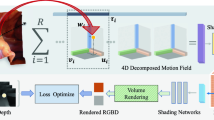Abstract
Commonly, surface and solid haptic effects are defined in such a way that they hardly can be rendered together. We propose a method for defining mixed haptic effects including surface, solid, and force fields. These haptic effects can be applied to virtual scenes containing various objects, including polygon meshes, point clouds, impostors, and layered textures, voxel models as well as function-based shapes. Accordingly, we propose a way how to identify location of the haptic tool in such virtual scenes as well as consistently and seamlessly determine haptic effects when the haptic tool moves in the scenes with objects having different sizes, locations, and mutual penetrations. To provide for an efficient and flexible rendering of haptic effects, we propose to concurrently use explicit, implicit and parametric functions, and algorithmic procedures.
Similar content being viewed by others
References
Schömer, E., Reichel, J., Warken, T.: Efficient collision detection for curved solid objects. In: Proc. 7th ACM Symposium on Solid Modeling and Applications, pp. 321–328. ACM, New York (2002)
El-Far, N.R., Georganas, N.D., El-Saddik, A.: A collision detection algorithm for point-like haptic interactions in highly detailed virtual environments. In: Proc. Virtual Environments, Human-Computer Interfaces and Measurement Systems, pp. 25–30. IEEE Computer Society, Los Alamitos (2007)
Brian, M.: V-Clip: fast and robust polyhedral collision detection. ACM Trans. Graph. 17(3), 177–208 (1998)
Moustakas, K., Tzovaras, D., Strintzis, M.G.: SQ-Map: Efficient layered collision detection and haptic rendering. IEEE Trans. Vis. Comput. Graph. 13(1), 80–93 (2007)
Raymaekers, C., Beets, K., Reeth, F.V.: Fast haptic rendering of complex objects using subdivision surfaces. In: Proc. 6th PHANToM Users Group Workshop, pp. 19–22 (2001)
Laehyun, K., Kyrikou, A., Sukhatme, G.S., Desbrun, M.: An implicit-based haptic rendering technique. In: Proc. IEEE/RSJ Intelligent Robots and Systems, vol. 3, pp. 2943–2948. IEEE Computer Society, Los Alamitos (2002)
Gregory, A., Lin, M.C., Gottschalk, S., Taylor, R.: A framework for fast and accurate collision detection for haptic interaction. In: Proc. ACM SIGGRAPH 2005 Courses, pp. 38–45. ACM, New York (2005)
Ruspini, D.C., Kolarov, K., Khatib, O.: The haptic display of complex graphical environments. In: Proc. 24th Annual Conference on Computer Graphics and Interactive Techniques, pp. 345–352. ACM, New York (1997)
Sourin, A., Wei, L.: Visual immersive haptic rendering on the web. In: Proc. 7th ACM SIGGRAPH International Conference on Virtual-Reality Continuum and Its Applications in Industry. ACM, New York (2008)
Burdea, G.C.: Force and Touch Feedback for Virtual Reality. Wiley, New York (1996)
Booth, S., Angelis, F.D., Schmidt-Tjarksen, T.: The influence of changing haptic refresh-rate on subjective user experiences—lessons for effective touch-based applications. In: Proc. EuroHaptics, pp. 374–383 (2003)
Weller, R., Zachmann, G.: A unified approach for physically-based simulations and haptic rendering. In: Proc. ACM SIGGRAPH Symposium on Video Games, pp. 151–159. ACM, New York (2009)
El-Far, N.R., Georganas, N.D., Saddik, A.E.: Collision detection and force response in highly-detailed point-based hapto-visual virtual environments. In: Proc. 11th IEEE International Symposium on Distributed Simulation and Real-Time Applications, pp. 15–22. IEEE Computer Society, Los Alamitos (2007)
Knott, D., Pai, D.K.: CInDeR: collision and interference detection in real time using graphics hardware. In: Proc. Graphics Interface, pp. 73–80 (2003)
Kolčárek, P., Sochor, J.: Velocity driven haptic rendering. In: Proc. 3rd International Conference on Computer Graphics and Interactive Techniques in Australasia and South East Asia, pp. 389–394. ACM, New York (2005)
Gregory, A., Mascarenhas, A., Ehmann, S., Lin, M., Manocha, D.: Six degree-of-freedom haptic display of polygonal models. In: Proc. Conference on Visualization, pp. 139–146. IEEE Computer Society, Los Alamitos (2000)
McNeely, W.A., Puterbaugh, K.D., Troy, J.J.: Advances in voxel-based 6-DOF haptic rendering. In: Proc. ACM SIGGRAPH 2005 Courses. ACM, New York (2005)
Hua, J., Qin, H.: Haptics-based volumetric modeling using dynamic spline-based implicit functions. In: Proc. IEEE Symposium on Volume Visualization and Graphics, pp. 55–64. IEEE Computer Society, Los Alamitos (2002)
Lundin, K., Gudmundsson, B., Ynnerman, A.: General proxy-based haptics for volume visualization. In: Proc. World Haptics Conference, pp. 557–560. IEEE Computer Society, Los Alamitos (2005)
Lundin, K., Lundström, C., Cooper, M., Ynnerman, A.: Enabling haptic interaction with volumetric MRI data through knowledge-based tissue separation. In: Proc. Volume Graphics, pp. 75–78 (2006)
Pasko, A.A., Adzhiev, V., Sourin, A., Savchenko, V.V.: Function representation in geometric modeling: concepts, implementation and applications. Vis. Comput. 11(8), 429–446 (1995)
Basdogan, C., Ho, C.-H., Srinivasan, M.A.: A ray-based haptic rendering technique for displaying shape and texture of 3d objects in virtual environments. In: Proc. ASME Dynamic Systems and Control Division, pp. 77–84 (1997)
Sourin, A., Wei, L.: Visual immersive haptic mathematics. Virtual Real. 13(4), 221–234 (2009)
Wei, L., Sourin, A., Sourina, O.: Function-based visualization and haptic rendering in shared virtual spaces. Vis. Comput. 24(10), 871–880 (2008)
Wei, L., Sourin, A., Stocker, H.: Function-based haptic collaboration in X3D. In: Proc. 14th International Conference on 3D Web Technology, pp. 15–23. ACM, New York (2009)
Author information
Authors and Affiliations
Corresponding author
Rights and permissions
About this article
Cite this article
Wei, L., Sourin, A. Function-based approach to mixed haptic effects rendering. Vis Comput 27, 321–332 (2011). https://doi.org/10.1007/s00371-011-0548-0
Published:
Issue Date:
DOI: https://doi.org/10.1007/s00371-011-0548-0




